In this part 1 post, I’ll teach you 7 important facts about the Amharic alphabet step by step so that you can recognize the Amharic letters shape easily. These facts will help you start identifying and distinguishing each Amharic letters quickly; especially when you see them used in words. Many beginners have learned to read Amharic with ease just by understanding these seven secrets, and you can too. This lesson will save you a lot of time, so read it till the end. After that, we’ll go through each Amharic letter along with its corresponding English transliteration.
What Does “Alphabet” Mean in Amharic?
In Amharic, “alphabet” is called “YeFidel gebeta” (የፊደል ገበታ), which literally means “the chart of fidel”—or the large paper that includes all the Amharic letters together.
- “Letter” is “hohie” (ሆሄ), which refers to a single character or letter.
- “Letters” (plural) is “hohieyat” (ሆሄያት), meaning letters or spellings.
- “Word” is “Qal” (ቃል).
- Also, the word “Amharic” is “Amarigna” (አማርኛ), and
- “Language” is “Quanqua” (ቋንቋ).
Many people ask about these terms, so I wanted to clarify them first.
How many letters are in the Amharic alphabet?
One of the most common questions Amharic learners ask is: “How many letters are there in the Amharic alphabet?”
You might have seen different numbers online, but based on my years of teaching Amharic, the correct answer is this:
The Amharic alphabet, known as Fidel Gebeta (ፊደል ገበታ), consists of 258 core consonant-vowel combination letters.
Let me break that down for you:
✅ 34 pure consonant letters – These are the foundational forms, including ‘ቭ’ (ve), which is often left out in many Fidel charts.
✅ 204 standard consonant-vowel combinations – These make up the majority of everyday written Amharic.
✅ 20 hybrid or irregular letters – These are crucial variations that enhance the language’s phonetic range.
That brings us to a total of 258 characters.
But Why Do Some Say There Are Only 33 Letters?
Many blog posts and even textbooks claim that Amharic has only 33 base consonants, each with 7 variations. But this is inaccurate and often confuses learners.
The truth is:
- Amharic has 34 base consonants, not 33.
- Most of these have 8 forms, not just 7.
- The 8th form includes hybrid characters, which play a real role in the modern language.
As someone who has worked closely with learners from all backgrounds, I’ve seen how this misunderstanding can slow progress. That’s why it’s important to start with the right information.
What About Rare or Unused Letters?
In addition to the 258 main letters, there are 10 or more archaic characters you’ll likely never use. These include symbols like ኰ, ኲ, ቊ, ቈ, ኊ, and ኈ.
They exist in the traditional Fidel charts, but they’re not used in modern writing or speech. Their origins are more historical than practical.
Do You Have to Memorize All 258?
Not at all.
Even native speakers don’t use every single letter in daily life. Many of them are rare, obsolete, or used only in religious texts.
In fact, out of the 258, you’ll regularly use only a much smaller group. That’s why I always tell my students:
Focus only on the most essential letters first.
I’ll show you exactly which ones to learn—and which ones you can safely skip for now.
Similar Sounds, Different Shapes
Another challenge for beginners is that some letters look different but sound the same—or nearly the same. Here are a few examples:
Three “h” sounds → ህ, ሕ, and ኅ
→ These form 22 letters across their full sets.
→ You only need to focus on 8 commonly used ones.
Two “s” sounds → ስ and ሥ
→ Total of 18 letters in these families.
→ Just 8 are commonly used; the others are optional.
Two “e” sounds → እ and ዕ
→ Create 17 “e” family letters, but 8 will cover most use cases.
Two “ts” sounds → ጽ and ፅ
→ They sound the same but have different shapes.
→ About 17–18 letters, but again, only 7–8 are essential.
Final Word: Don’t Feel Overwhelmed
Yes, Amharic has many letters—but you don’t need to learn them all at once. And you certainly don’t have to memorize every variation.
My goal is to make your learning process simple and effective.
I’ll guide you step by step—showing you which letters are key to fluent reading and writing, and which ones you can safely ignore (at least for now).
Up next, I’ll teach you 7 simple methods that will help you master the sounds and shapes of Amharic letters in a clear and stress-free way.
The 7 facts you should know about the Amharic alphabet:
The letters in the first row are all simple letters with little addition to their bodies. They are pronounced like “ኧ” or “eh, e.”
Amharic Alphabet Fact 1:
The letters in the first row are all simple letters with little addition to their bodies. They are pronounced like “ኧ” or “eh, e.”
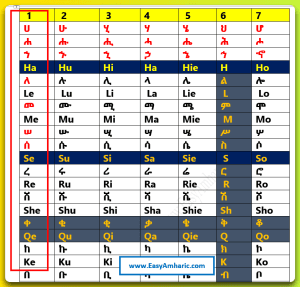
Amharic Alphabet Fact 2:
The Amharic letters in the second row have a small mark on their right side, but the suffix mark for “ሩ and ፉ” is under them. This symbol makes them read as “u.” Example: ሁ Hu፣ ሉ Lu፣ ሙ Mu.
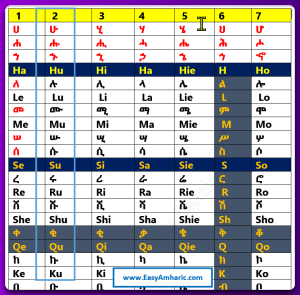
Amharic Alphabet Fact 3:
All the Amharic letters except “ሪ ri, ዪ yi, and ፊ fi” in the third row have a right-pointing suffix on their right leg. For example: ሂ hi፣ ሊ Li፣ ሚ, ሲ Si, etc. This suffix makes the Amharic letter read as “i.”
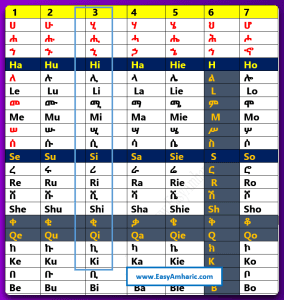
Amharic Alphabet Fact 4:
The letters with two or more legs, such as “ሓ/ha, ላ/la, ሳ/sa, ባ/ba” in the fourth row, have the shortest leg on the left. That is why they are pronounced as “a.” You can look at them now.
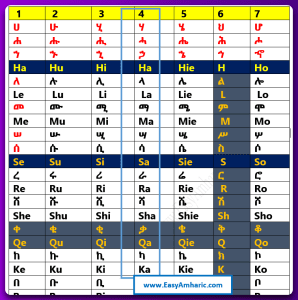
Amharic Alphabet Fact 5:
Figure 5: All the Amharic letters in the fifth row have a ring on their right leg. This makes them read as “ie.” For example: ሄ Hie, ሌ Lie, ሜ Mie, ሤ, ሴ, Sie.
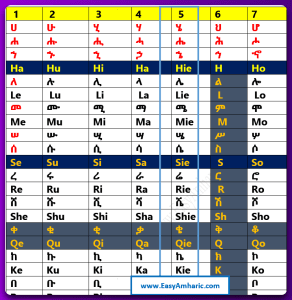
Amharic Alphabet Fact 6:
But the Amharic alphabet in the sixth row are consonant letters. So we need to read them like “ህ H, ል L, ም M, ስ S, ር R.” For example, “ምስር / MSR,” which means “lentil,” and “ስድስት / SDST,” which means “six.” If we add another vowel symbol to these letters, their shape, sound, and meaning will change. The remaining 6 letters are vowel letters. They change their shape and sound due to the addition of vowel letters. (አ, ኡ, ኢ, ኣ, ኤ, ኦ, (a u i a ie o)
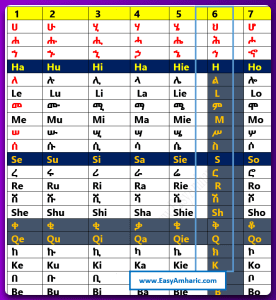
Amharic Alphabet Fact 7:
The letters in the seventh row, such as “ሆ / ho, ሎ / lo, ሮ / ro, ኖ / no,” have a ring on the right. Two-legged letters like “ሶ / so, ቦ / bo, ሾ / sho” have the shortest leg on the right. And those with one leg, like Fidel, ቆ / Qo, ቾ / Cho, and ቶ / To, have a ring mark on their head. But they are all pronounced as “o.”
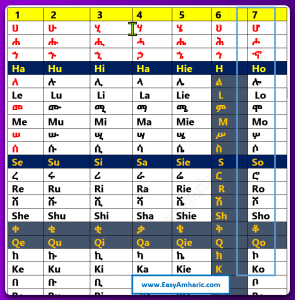
If you understand these facts well, you can learn and even memorize these Amharic letters very easily. Now, when you read the letters below, read them keeping in mind the facts that we have seen above. But if you have a problem with pronouncing these Amharic letters correctly, contact me on Telegram; I will give you a 1-hour paid tutor for only $10.
I will teach you additional facts in the next lessons about the Amharic alphabet, but now read the following Amharic alphabet using the transliterations under each of them or by watching this short YouTube video.
Read the Amharic Alphabet Full Chart:
I have listed below the complete Amharic letters with English transliterations and audio. Read them carefully while listening to the audio at the same time, so you will not get confused about the Amharic letters again.
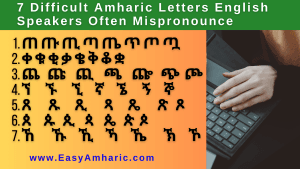
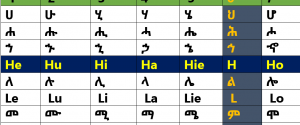
Selam,
You’re a good teacher. You can sell Amharic courses on Udemy, Skillshare, etc., or, if you prefer, host your courses on platforms like Teachable or Thinkific.
Canva.com is a great place to create videos/lessons.
Berta! You can do this.
This isn’t my real email. I just wanted to send you a message.